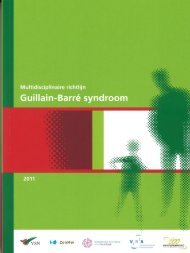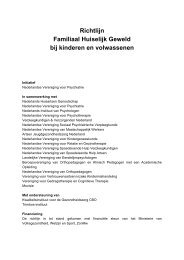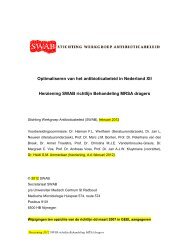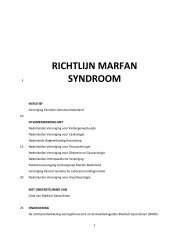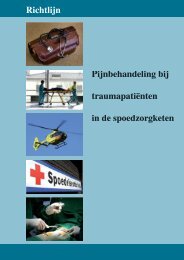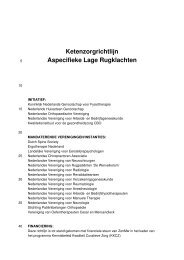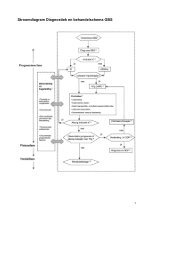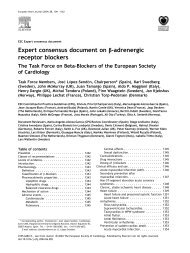Richtlijn: Otitis Externa - Kwaliteitskoepel
Richtlijn: Otitis Externa - Kwaliteitskoepel
Richtlijn: Otitis Externa - Kwaliteitskoepel
You also want an ePaper? Increase the reach of your titles
YUMPU automatically turns print PDFs into web optimized ePapers that Google loves.
Chirurgie<br />
Uitgangsvraag 8:<br />
Wat is de effectiviteit van een chirurgische behandeling van patiënten met chronische otitis externa?<br />
Onderbouwing:<br />
In chronic and recurrent otitis externa swelling and hypertrophy of the skin of the earcanal are<br />
persisting and topical treatment becomes ineffective. In these patients surgical management is<br />
indicated. With respect to the surgical treatment of chronic otitis externa and its clinical outcome<br />
conclusions are based on observational studies as randomized trials are lacking. Studies regarding<br />
myringitis bullosa and myringitis granulomatosa were excluded as these conditions are outside the<br />
scope of this guideline.<br />
Depending on the condition of the skin and subcutaneous tissue of the medial part of the earcanal,<br />
surgical treatment is directed at the meatus or at the entire ear canal, including the lateral epithelial<br />
layer of the tympanic membrane.<br />
In chronic pathology, like chronic otitis externa, the humidity in the ear canal is significantly higher<br />
than under normal conditions (Gray 2005). Goal of the surgical procedure is to establish an open,<br />
ventilating ear canal and to facilitate reoccurrence of normal physiology (Parisier 1996). The<br />
procedure is mainly aimed at widening the meatus and/or ear canal.<br />
Meatoplasty<br />
The surgical procedure might entail the excision of pathological skin, subcutaneous tissue and<br />
underlying cartilage. If the cause of the chronic or recurrent otitis externa is identified at the level of<br />
the meatus or lateral part of the earcanal, for example in the case of impingement of the conchal<br />
cartilage over the meatus, surgery may be limited merely to a meatoplasty. In these cases, only skin,<br />
subcutis and conchal cartilage is removed through an endaural approach (Hunsaker 1980, Rombout<br />
2001, Kumar 2007).<br />
Canalplasty<br />
In patients with pathology of the medial part of the ear canal, often including the tympanic<br />
membrane, performing a canalplasty may be considered. In most canalplasty techniques, pathologic<br />
skin and subcutaneous tissue is excised and the bony ear canal is widened using a drill. Sometimes it<br />
is necessary to remove the lateral epithelial layer of the tympanic membrane as well (Paparella<br />
1966). Some have described a technique which refrains from drilling the ear canal (Proud 1966) but<br />
which may lead to a higher rate of recurrence (Cremers 1991). Canal plasty is also performed in cases<br />
of an acquired atresia of the ear canal, observed equally frequent as a result of chronic otitis externa<br />
(37%) as of chronic otitis media (43%), and in patients with cholesteatoma of the ear canal (Jacobson<br />
2006, Becker 1998,).<br />
Canalplasty can be performed with an endaural approach (Banerjee 1995, Sharp 2003) or combined<br />
with a retro-auricular approach (Parisier 1996, Cremers 1991). In case more than half of the skin is<br />
missing after the widening of the earcanal it is advisable to use skin transplants to provide enough<br />
38 <strong>Richtlijn</strong> <strong>Otitis</strong> <strong>Externa</strong> 2010<br />
Nederlandse Vereniging voor Keel-Neus-Oorheelkunde en Heelkunde van het Hoofd-Halsgebied




